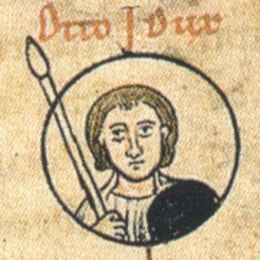Otto I, Duke of Saxony
Otto I , the Illustrious (* 830/40; † 30 November 912) from the noble family of the Liudolfing was lay abbot of Hersfeld from 902 to 912.
The younger son of Count Liudolf became head of the Liudolfing dynasty in 880 as successor to his brother Brun, who died in the Battle of the Normans. Otto was count in the Derlin(g)gau, in the Südthüringgau and in the Eichsfeld.
In a tithe register of the Hersfeld monastery he is already attested as "duke" (dux) towards the end of the 9th century. Even King Conrad I, a long-time rival, referred to him retrospectively as dux in 913. Fifty years later, Otto was even referred to as duke of all Saxony by Widukind of Corvey. The Carolingians, on the other hand, refused to give him the title of dux and merely acknowledged him in their documents as an outstanding count.
Otto married probably around 875 Hadwig, a daughter of a nobleman named Heinrich, who belonged to the Frankish noble family of the elder Babenbergs. Otto had three sons with Hadwig, Thankmar, Liudolf and the later King Henry I, as well as two daughters Oda and Liutgard.
Otto accompanied Arnolf on the Italian campaign at the beginning of 894. At the request of the Pope, Arnolf was to fight the tyrant Emperor Wido of Spoleto. Otto was given the task of securing the city of Milan. For his loyal service he received the Hessian imperial monastery of Hersfeld a few years later. As a lay abbot, he had a decisive influence on this important institution in the Saxon-Franconian border region. Otto's importance in the power structure of the East Frankish Empire is shown by the fact that his daughter Oda was married to Zwentibold, the son of Emperor Arnolf. Through this marriage, the emperor attempted to integrate Otto into the Carolingian ruling family as the most powerful man in eastern Saxony.
Under the new ruler Louis the Child, Otto had no particular closeness to the royal court. He had to confine himself to his core territories in the northeast of the empire at the Harz and on the Elbe. Otto only appeared twice as an intervener, in August 902 in Trebur in a legal confirmation for the Church of Halberstadt and on 8 May 906 in Holzkirchen in a legal confirmation for the Church of Freising. According to the Saxon historian Widukind von Corvey, after the death of Louis the Child the "people of the Saxons and Franks" offered Otto the royal crown. The latter, however, refused for reasons of age. However, the real power is said to have remained with Otto.
Otto the Illustrious was buried in the church of Gandersheim Abbey. A commemorative plaque about him can be found in the Walhalla in Donaustauf.

Otto I, the Illustrious (detail) in the kinship table of the Ottonians in a manuscript of the Chronica Sancti Pantaleonis from the early 13th century (Wolfenbüttel, Herzog August Bibliothek, Cod. Guelf. 74.3 Aug. 2°, pag. 226).
Search within the encyclopedia